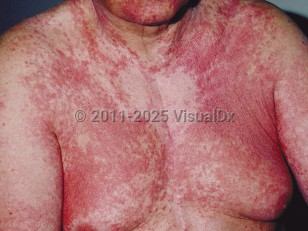Autoeczematization in Child
Alerts and Notices
Important News & Links
Synopsis

Id reaction, also known as autoeczematization, secondary dermatitis, autosensitization dermatitis, and generalized eczema, occurs when eczema develops at sites not affected by a primary inciting dermatosis. In children, it is usually observed with allergic or irritant contact dermatitis, infections (typically fungal), and, in adults, stasis dermatitis with allergic contact dermatitis, but it is also seen in association with stasis dermatitis without contact dermatitis, inflammatory tinea pedis, and other forms of eczematous dermatitis. The reaction usually appears a few days to weeks after the primary dermatitis and can be severely pruritic. It shows a symmetric distribution and has a predilection for the palms, soles, and extensor surfaces of the upper extremities. All ages and populations, and both sexes, are equally affected.
In children, id reaction is most often observed after a kerion or severe tinea capitis. In this case, the id reaction typically affects the upper body and face. Id reaction is also commonly observed in children in association with allergic contact dermatitis to nickel.
The condition is thought to result from a lower threshold for developing an eczematous hypersensitivity reaction in patients with preceding or concurrent inflammatory processes of the skin. Memory T-cells are thought to play a role in the cases of id reaction associated with allergic contact dermatitis.
In children, id reaction is most often observed after a kerion or severe tinea capitis. In this case, the id reaction typically affects the upper body and face. Id reaction is also commonly observed in children in association with allergic contact dermatitis to nickel.
The condition is thought to result from a lower threshold for developing an eczematous hypersensitivity reaction in patients with preceding or concurrent inflammatory processes of the skin. Memory T-cells are thought to play a role in the cases of id reaction associated with allergic contact dermatitis.
Codes
ICD10CM:
L30.2 – Cutaneous autosensitization
SNOMEDCT:
3014005 – Id reaction
L30.2 – Cutaneous autosensitization
SNOMEDCT:
3014005 – Id reaction
Look For
Subscription Required
Diagnostic Pearls
Subscription Required
Differential Diagnosis & Pitfalls

To perform a comparison, select diagnoses from the classic differential
Subscription Required
Best Tests
Subscription Required
Management Pearls
Subscription Required
Therapy
Subscription Required
References
Subscription Required
Last Reviewed:02/03/2021
Last Updated:03/14/2024
Last Updated:03/14/2024
Autoeczematization in Child

